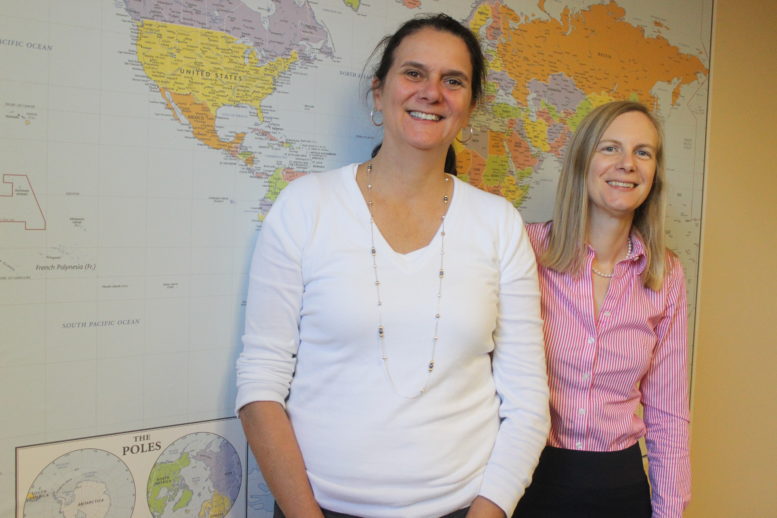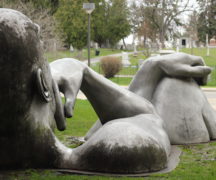By DAVID DUPONT
BG Independent News
The last few decades have not been easy on the Norman Rockwell portrait of the American family’s holiday dinner. Those neatly delineated generations and family relationships are a thing of the past.
The grandchildren may be the products of parents who live together without marriage. Or they may be the children of a same-sex couple.
The grown son or daughter still lives at home with mom and dad, who may be contemplating divorce.
Grandma has brought along her special friend. They are a committed couple, but live apart from each other, and have no intention of altering that arrangement.
All this change, say Wendy Manning and Susan Brown, co-directors of the National Center for Family and Marriage Research at Bowling Green State University, may cause some observers to despair.
Some take a dim view of the decreasing marriage rate and see it as a sign of the decline of the American family, said Brown. But “if you’re open to a diverse range of shapes a family can take, it has never been better because people can form the types of families they want to form. We’re more accepting of a wide range of family relationships, and people have the opportunity to build the kind of families they want to be part of.”
“There’s a lot of trends that are ongoing that make this an especially exciting time to be studying the American family,” Manning, a distinguished research professor, said.
The two researchers and their faculty colleagues and graduate students have had a front row seat, and even a role, in these changes through their research.
Manning did research for the American Psychological Association’s amicus brief for the two Supreme Court cases that established same sex marriage in the United States. Her research found “overwhelming evidence that children fare as well in same sex families as in different sex families.”
Manning said: “That research made a difference.” It demonstrated “the appropriate role for us to play in examining the literature.”
This fall, the center marked the 10th anniversary of its founding. In July, 2007, the U.S. Department of Health and Human Services, put out a call for proposals for a national center for marriage research.
Given BGSU was already the home for the Center for Family and Demographic Research, and that BGSU faculty were already heavily involved in studying a range of issues relating the family, this seemed a natural fit.
“We felt we had the expertise to satisfy those goals,” said Brown, who chairs the Sociology Department. “We were in a position to articulate for scholars what the key questions were surrounding family structure, child well-being, adult well-being, community well-being. For us, it wasn’t a stretch. We felt we have the people and the critical mass here and the track record to be successful.”
They had a month to respond with an application. Brown remembers it “as a whirlwind” with long nights of work reminiscent of her days as a graduate student. But in October BGSU learned it had the winning application. Though the federal funding has since gone away, the center continues to thrive.
The center both analyzes federal data and collects its own. The center disseminates that data in profiles to more than 2,000 recipients and on its website (https://www.bgsu.edu/ncfmr.html).
The center prides itself on measuring the increasingly complex social context in which people live, Brown said. “That’s one of our contributions.”
Brown, Manning and others affiliated with the center frequently field calls from the national media, probing family related issues.
Some of those can be specific to a state or age group, and demand digging on the part of scholars. Sometimes, Manning said, they asked about angles the center hasn’t previously considered. That’s just goes with having a strong reputation in the field.
“It’s a good problem to have,” she said.
The acceptance of same-sex marriage is just one of the myriad of changes the family has undergone in the past decade.
Among the trends that Brown is focused on is Living Apart Together.
In these cases, Brown said, people, often older adults, are committed to each other, but they choose not to share a home, nor do they plan to marry or cohabitate.
Manning said the center is on “the cutting edge” of studying this trend.
The center has also looked at the trend of young adults delaying marriage.
They may continue to live at home with their parents. “Most of these relationships are pretty positive and satisfactory to both parties,” Brown said. “When we were young we couldn’t wait to get out. Now I don’t think that’s the prevailing sentiment.”
Or they may live with a partner without bring married. The longer they put off marriage, the more such relationships an individual may have. So they are looking at “serial cohabitation,” Brown said.
This can influence educational and employment choices, Manning said. “There was once a linear pathway. Now it’s varied. It can be fulfilling but can create anxieties about your future especially when you have declining prospects for young adults where they will not do as well as their parents.” The high level of college debt further complicates their situations.
They may have children before getting married. Manning said the average age of woman giving birth for the first time is now four to five years younger than the average age of her being married for the first time.
The rise in the number of out-of-wedlock births, now over 40 percent, Manning said, is driven by co-habitation rather than single motherhood.
“Cohabitating couples are not the equivalent to marriage,” she said. “The children of cohabitating parents are likely to experience the breakup of parents early in life.”
This instability is not restricted to the young.
Brown has been looking at the increasing rate of divorce among those 50 and older.
The rate of divorce overall is steady, but more is occurring later in life, she said.
“This raises all kinds of issues,” Brown said. The effects “may be benign” if the parties are in good health and are economically secure. “But if they’re economically disadvantaged and in declining health, it can be quite devastating.”
“They don’t have 30 more years in the labor to make up for the shock,” Brown said “They may not be able to get into the labor force. And while some of these people will go on to form new unions, most will not, particularly among women.”
The reasons for these breakups vary. As people age, they change and may grow apart, differences that are exacerbated when the children leave and they have only each other. With life expectancy increasing, people may decide they don’t want to spend their remaining decades with their spouse. Also, more of these marriages may be second or third unions, which are more likely to end in divorce.
This causes other concerns, Brown said. “Who will take care of them because we have typically relied on spouses as the first line of defense?”
Questions are not in short supply at the center.
“We have many, many projects,” Brown said. “More projects than time.”
All this, she said, “provides a great training ground for our students.”
The four graduate assistants affiliated with the center are creating the research products that are disseminated on the website, and they also get interviewed by journalists about that research. “It’s a fabulous experience for them,” Brown said.
These graduate students represent a legacy of the center. “The goal,” Brown said, “was always to shape research at a national level.”





